mu-Opioid receptor knockout mice are insensitive to methamphetamine-induced behavioral sensitization
- PMID: 20209629
- PMCID: PMC3086557
- DOI: 10.1002/jnr.22386
mu-Opioid receptor knockout mice are insensitive to methamphetamine-induced behavioral sensitization
Abstract
Repeated administration of psychostimulants to rodents can lead to behavioral sensitization. Previous studies, using nonspecific opioid receptor (OR) antagonists, revealed that ORs were involved in modulation of behavioral sensitization to methamphetamine (METH). However, the contribution of OR subtypes remains unclear. In the present study, using mu-OR knockout mice, we examined the role of mu-OR in the development of METH sensitization. Mice received daily intraperitoneal injection of drug or saline for 7 consecutive days to initiate sensitization. To express sensitization, animals received one injection of drug (the same as for initiation) or saline on day 11. Animal locomotor activity and stereotypy were monitored during the periods of initiation and expression of sensitization. Also, the concentrations of METH and its active metabolite amphetamine in the blood were measured after single and repeated administrations of METH. METH promoted significant locomotor hyperactivity at low doses and stereotyped behaviors at relative high doses (2.5 mg/kg and above). Repeated administration of METH led to the initiation and expression of behavioral sensitization in wild-type mice. METH-induced behavioral responses were attenuated in the mu-OR knockout mice. Haloperidol (a dopamine receptor antagonist) showed a more potent effect in counteracting METH-induced stereotypy in the mu-OR knockout mice. Saline did not induce behavioral sensitization in either genotype. No significant difference was observed in disposition of METH and amphetamine between the two genotypes. Our study indicated that the mu-opioid system is involved in modulating the development of behavioral sensitization to METH. (c) 2010 Wiley-Liss, Inc.
Figures
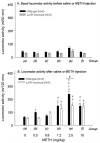
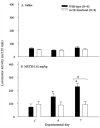
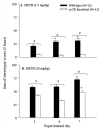
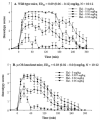
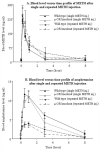
Similar articles
-
Methamphetamine-induced changes in the striatal dopamine pathway in μ-opioid receptor knockout mice.J Biomed Sci. 2011 Nov 10;18(1):83. doi: 10.1186/1423-0127-18-83. J Biomed Sci. 2011. PMID: 22074218 Free PMC article.
-
Methamphetamine-induced expression of zif268 mRNA is prevented by haloperidol in mice lacking mu-opioid receptor.Neurotoxicology. 2010 Jun;31(3):326-30. doi: 10.1016/j.neuro.2010.02.002. Epub 2010 Feb 23. Neurotoxicology. 2010. PMID: 20184921 Free PMC article.
-
Attenuated methamphetamine-induced locomotor sensitization in serotonin transporter knockout mice is restored by serotonin 1B receptor antagonist treatment.Behav Pharmacol. 2015 Feb;26(1-2):167-79. doi: 10.1097/FBP.0000000000000120. Behav Pharmacol. 2015. PMID: 25485646
-
Differential modulation of methamphetamine-mediated behavioral sensitization by overexpression of Mu opioid receptors in nucleus accumbens and ventral tegmental area.Psychopharmacology (Berl). 2016 Feb;233(4):661-72. doi: 10.1007/s00213-015-4134-4. Epub 2015 Nov 10. Psychopharmacology (Berl). 2016. PMID: 26554386 Free PMC article.
-
Comparison of single versus repeated methamphetamine injection induced behavioral sensitization in mice.Neurosci Lett. 2014 Feb 7;560:103-6. doi: 10.1016/j.neulet.2013.12.024. Epub 2013 Dec 19. Neurosci Lett. 2014. PMID: 24361545 Free PMC article.
Cited by
-
Argon prevents the development of locomotor sensitization to amphetamine and amphetamine-induced changes in mu opioid receptor in the nucleus accumbens.Med Gas Res. 2014 Dec 29;4(1):21. doi: 10.1186/s13618-014-0021-z. eCollection 2014. Med Gas Res. 2014. PMID: 25606340 Free PMC article.
-
The Adverse Effects of Prenatal METH Exposure on the Offspring: A Review.Front Pharmacol. 2021 Jul 14;12:715176. doi: 10.3389/fphar.2021.715176. eCollection 2021. Front Pharmacol. 2021. PMID: 34335277 Free PMC article. Review.
-
15 years of genetic approaches in vivo for addiction research: Opioid receptor and peptide gene knockout in mouse models of drug abuse.Neuropharmacology. 2014 Jan;76 Pt B(0 0):204-17. doi: 10.1016/j.neuropharm.2013.08.028. Epub 2013 Sep 10. Neuropharmacology. 2014. PMID: 24035914 Free PMC article. Review.
-
Pharmacotherapy for stimulant-related disorders.Curr Psychiatry Rep. 2013 Nov;15(11):415. doi: 10.1007/s11920-013-0415-y. Curr Psychiatry Rep. 2013. PMID: 24142188 Free PMC article. Review.
-
Immediate-Early Genes Modulation by Antipsychotics: Translational Implications for a Putative Gateway to Drug-Induced Long-Term Brain Changes.Front Behav Neurosci. 2017 Dec 11;11:240. doi: 10.3389/fnbeh.2017.00240. eCollection 2017. Front Behav Neurosci. 2017. PMID: 29321734 Free PMC article. Review.
References
-
- Bartlett E, Hallin A, Chapman B, Angrist B. Selective sensitization to the psychosis-inducing effects of cocaine: a possible marker for addiction relapse vulnerability? Neuropsychopharmacology. 1997;16:77–82. - PubMed
-
- Callaway CW, Kuczenski R, Segal DS. Reserpine enhances amphetamine stereotypies without increasing amphetamine-induced changes in striatal dialysate dopamine. Brain Res. 1989;505:83–90. - PubMed
-
- Costall B, Naylor RJ, Olley JE. The substantia nigra and stereotyped behaviour. Eur J Pharmacol. 1972;18:95–106. - PubMed
-
- Devine DP, Leone P, Wise RA. Mesolimbic dopamine neurotransmission is increased by administration of mu-opioid receptor antagonists. Eur J Pharmacol. 1993;243:55–64. - PubMed
Publication types
MeSH terms
Substances
Grants and funding
LinkOut - more resources
Full Text Sources
Medical
Molecular Biology Databases
Research Materials

